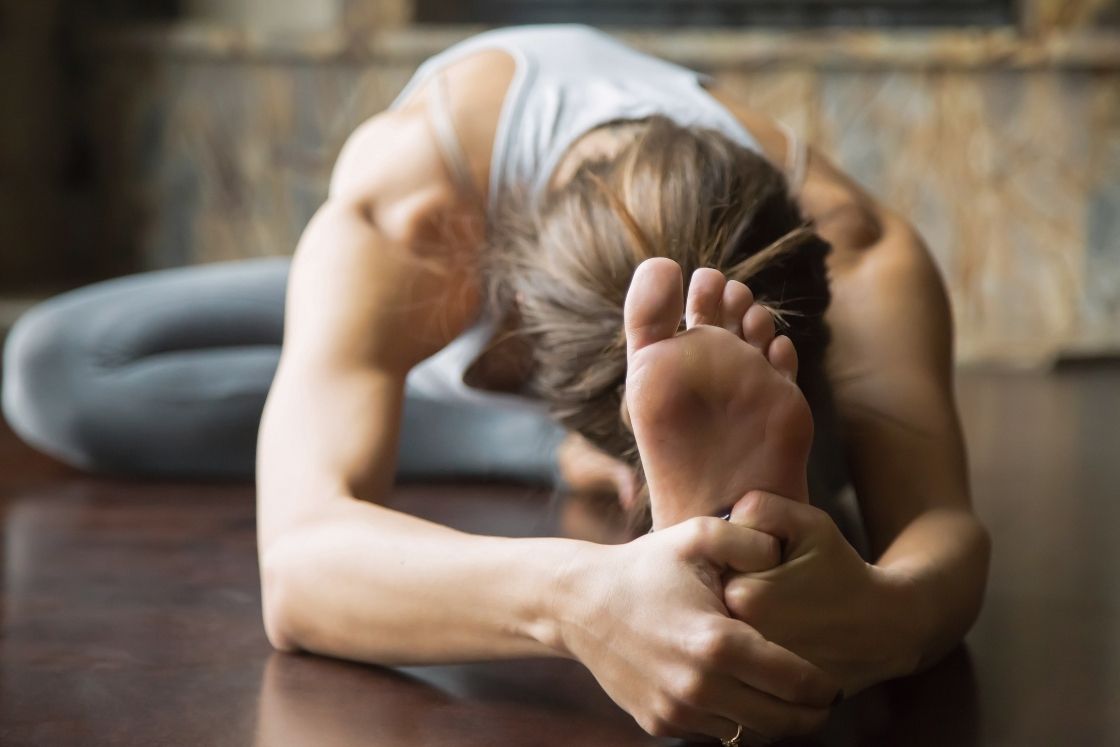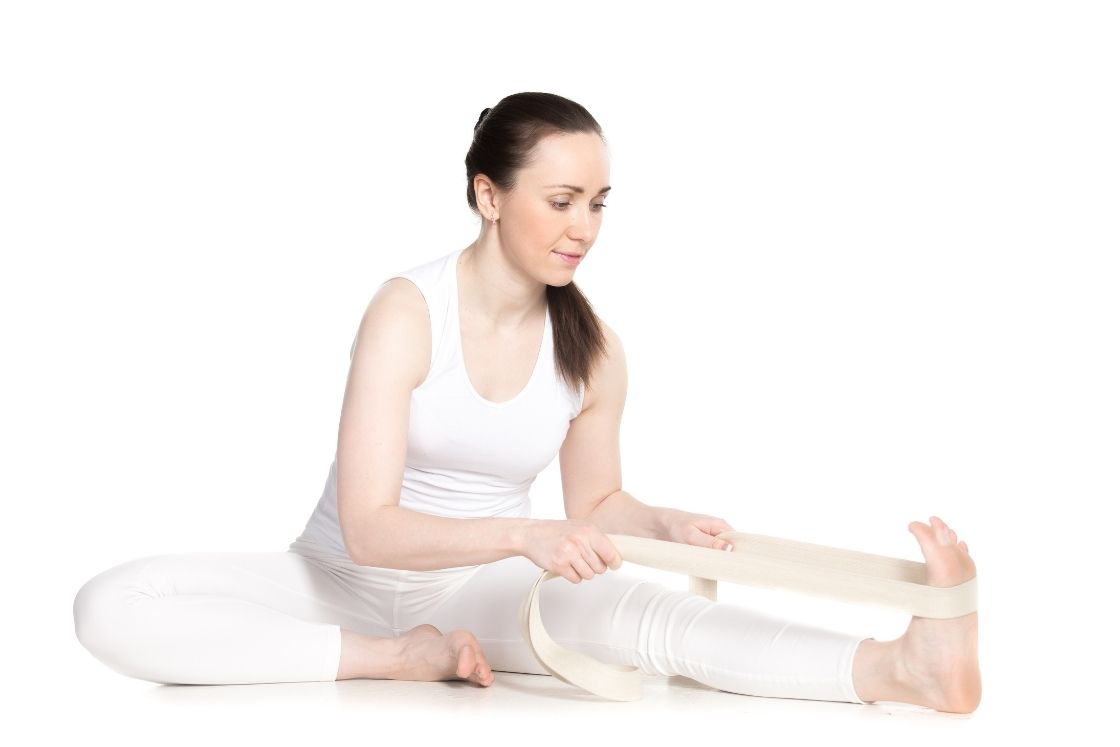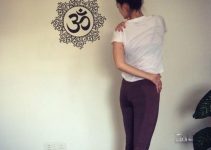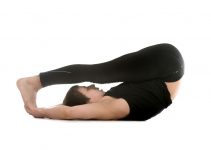
Janu sirsasana is an asymmetric forward bending pose that involves stretching and twisting together. It belongs to the primary Ashtanga yoga series and a beginner level pose.
It is also known by the many other names such as; Head-on-knee Pose, Head-to-knee forward bend, or Seated head to knee pose.
The main target muscles in this pose are the neck, lower back, hips, and hamstrings.
Janu Sirsasana Meaning
In Janu Sirsasana, ‘Janu‘ means ‘knee’, ‘Sirsa‘ refers to ‘head’, and asana means pose.
While performing this pose, the trunk is bent forward so the head touches the knee in the final posture, and hence the name Janu-sirs-asana. It involves forward bend, twist, and side stretch of the body. The forward bend is associated with creating a self-reflection.
It brings inner peace and calmness and hence practiced as a restorative pose. The stretches involved bring flexibility to the spine, groins, and hamstrings.
Janu Sirsasana Practice Guide

The pose is very simple to perform. Before begin Janu sirsasana practice, it’s better to check what safety measure is required and in which condition it should be avoid.
Precautions & Contraindications
- Patients of Asthma should not practice janu sirsasana.
- Do not perform this asana if you are suffering from Diarrhea.
- Avoid straining an injured knee by flexing it fully to perform janu sirsasana.
- Do not practice it if you have a lower back injury or lumbar disc herniation.
- Use the pelvic muscles and then the spinal muscles while bending forward.
- Stretch to a limit that is comfortable for you to prevent injury. Do not rush to attain the pose by clasping the toe.
Preparatory Poses
- Downward Facing Dog Pose (Adho Mukha Svanasana)
- Bound Angle Pose (Baddha Konasana)
- Standing Forward Bend (Uttanasana)
- Tree Pose (Vrikshasana)
How to Do Janu Sirsasana (Steps)
- Begin with sitting in dandasana.
- Bring the sole of your right foot towards you by bending the knee.
- Let the heel of the right foot touch the perineum and the left leg remain stretched forward.
- Inhale, raise your hands overhead.
- As you exhale bend forward with your hands grasping your left toe.
- Bend your trunk forward with further exhalation and reach your head to your left knee.
- Maintain the posture for 30-60 seconds breathing deeply.
- Inhale bringing your head up, lift the torso and take your arms overhead.
- Exhale and draw your hands to your sides and stretch your right leg.
- Relax for a few seconds and repeat the same step by bending the left leg.
Beginner’s tips
- Do not let your folded foot to slide under the stretched leg. Press it against the inner groin and keep it active.
- Ensure that you can look at the sole of the bent leg.
Follow-up Poses
Modifications and Props

To ease the difficulty in bending forward in janu sirsasana, you can use the following props;
- Blanket – Place a folded blanket under the hips while performing the asana. It prevents the rounding of the lower back while bending forward and facilitates the forward tilt of the pelvis.
- Yoga strap – Wrap a yoga strap around the balls of the stretched foot, hold on to while bending forward. It increases the stretch in the hamstring muscles while lengthening the spine.
- Cushion – Place a cushion/folded blanket under the bent leg. It will superficially touch the knees the ground and supports the knee and ankle.
Janu Sirsasana Variations
- Janu sirsasana B – (Keeping the right leg bent): In this variation, the pelvis rests on the top of your bent-knee-heel. After bending forward, instead of grabbing the big toe clasp your left wrist by right hand around your left foot’s sole.
- Janu sirsasana C – Here, the bent foot is externally rotated so that that toes touch the ground while the heel lies above the toes. Ensure that there is a bent in the ankle. Finally, as you bend forward the heel touches the navel. The position of hands remains the same as Janu sirsasana B.
- Parivrtta janu sirsasana pose – (If the left leg is stretched out): The left-hand grabs the left big toe, leaning forward and touching the elbow to the ground. The right arm then also reaches the left foot extending over the head. In the final position, the head lies in between the two arms.
- One Hand on knee variation – Keeping the right knee bent, the left-hand rests on the right knee. However, the right-hand reaches over to grab the left big toe by leaning forward.
Janu Sirsasana Benefits
1. Provides strength and flexibility
Janu sirsasana is the best pose to give a deep stretch to the muscles. It involves stretching the neck, shoulders, spine, hamstrings, abdominal muscles, and groins. During forward bend, all of them are involved.
Due to deep stretching, flexibility improves and it makes the muscles stronger.
2. Improves digestion
The abdominal muscles are involved in the forward bending. These muscles experience immense pressure that produces stress hormones. The pressure also massages the abdominal organs and hence improves the efficiency of the digestive system.
3. Maintains hormonal balance
Due to the pressure on the muscles various organs like the kidney, liver, pancreas, spleen, the uterus is stimulated. It improves hormone secretion. This also helps in the detoxification process.
4. Stimulates reproductive system
The reproductive organs are also stimulated with its practice. Along with this, it relieves menstrual cramps as well as reduces the symptoms of menopause.
It is also helpful in curing impotency in males.
5. Better respiration
Holding the final posture involves slow deep breathing. It helps in the expansion of the chest and lungs. It also supplies fresh blood to the diaphragm. It eventually improves the respiratory system.
6. Relieves mental disorders
It is a restorative pose. It calms the mind by clearing the mental blocks. Janu sirsasana helps in getting rid of fatigue, insomnia, and anxiety. It is even helpful in curing mild depression.
According to a study, janu sirsasana acts as a stress reliever and uplifts mood.




